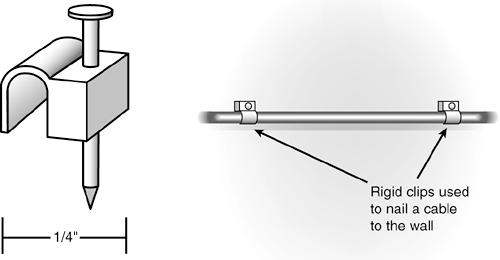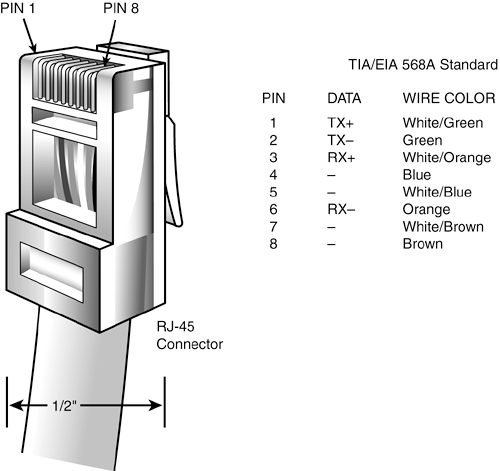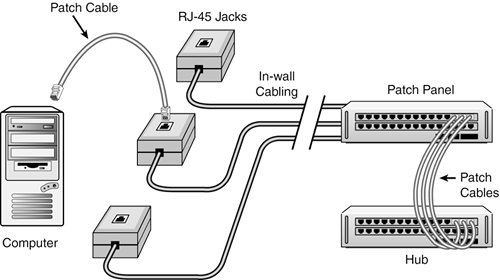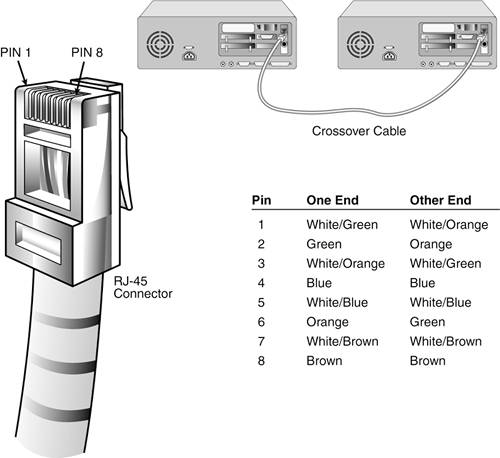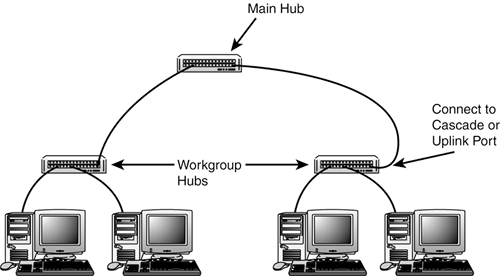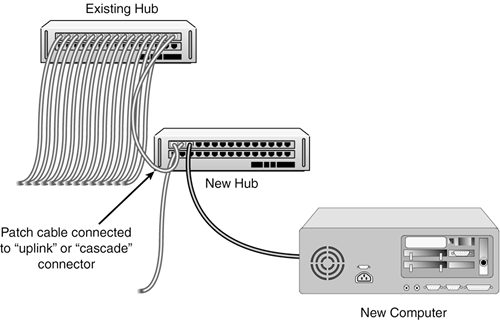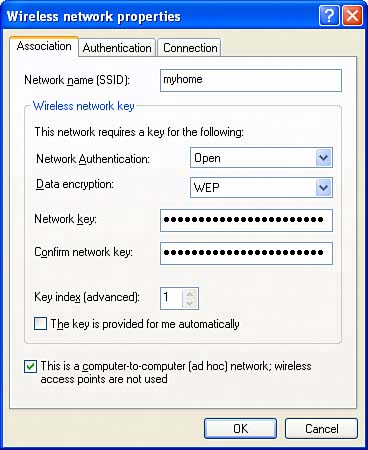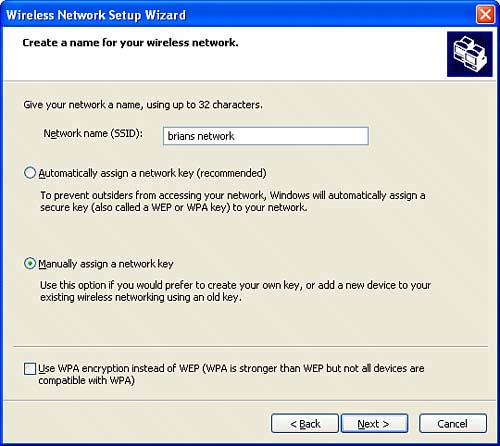Installing Network Wiring
| When your network adapters are installed, the next step is to get your computers connected together. Installing the wiring can be the most difficult task of setting up a network. How you proceed depends on the type of networking adapters you have:
Otherwise, you're using UTP Ethernet adapters and you have to decide how to route your wiring and what type of cables to use. The remainder of this section discusses UTP wiring. Cabling for Ethernet NetworksIf your computers are close together, you can use pre-built patch cables to connect your computers to a hub. (The term patch cable originated in the telephone industryin the old days, switchboard operators used patch cables to temporarily connect, or patch, one phone circuit to another. In networking, the term refers to cables that are simply plugged in and not permanently wired.) You can run these cables through the habitable area of your home or office by routing them behind furniture, around partitions, and so on. Just don't put them where they'll be crushed, walked on, tripped over, or run over by desk chair wheels. If the cables need to run through walls or stretch long distances, you should consider having them installed inside the walls with plug-in jacks, just like your telephone wiring. I'll discuss this later in this section. Hardware stores sell special cable covers you can use if you need to run a cable where it's exposed to foot traffic, as well as covers for wires that need to run up walls or over doorways. TIP As you install each network card and plug it into the cables running to your hub, you should see a green light come on at the hub and on the network adapter. These lights indicate that the network wiring is correct.
General Cabling TipsYou can determine how much cable you need by measuring the distance between computers and your hub location(s). Remember to account for vertical distances, too, where cables run from the floor up to a desktop, or go up and over a partition or wall. CAUTION If you have to run cables through the ceiling space of an office building, you should check with your building management to see whether the ceiling is listed as a plenum or air-conditioning air return. You may be required by law to use certified plenum cable and follow all applicable electrical codes. Plenum cable is specially formulated not to emit toxic smoke in a fire. Keep in mind the following points:
NOTE If you really want to get into the nuts and bolts, so to speak, of pulling your own cable, a good starting point is Que's Practical Network Cabling, which will help you roll up your shirtsleeves and get dirty (literally, if you have to crawl around through your attic or wrestle with dust bunnies under too many desks at the office). Wiring with Patch CablesIf your computers are close together and you can simply run prefabricated cables between your computers and hub, you've got it made! Buy CAT-5 cables of the appropriate length online or at your local computer store. Just plug (click!), and you're finished. Figure 16.1 shows how to connect your computers to the hub. If you have the desire and patience, you can build custom-length cables from crimp-on connectors and bulk cable stock. Making your own cables requires about $75 worth of tools, though, and more detailed instructions than I can give here. Making just a few cables certainly doesn't make buying the tools worthwhile. Factory-assembled cables are also more reliable than homemade ones because the connectors are attached by machine. They're worth the extra few dollars. For the ambitious or parsimonious reader, Figure 16.7 shows the correct way to order the wires in the connector. Figure 16.7. Standard wiring order for UTP network cables.
Installing In-Wall WiringIn-wall wiring is the most professional and permanent way to go. However, this often involves climbing around in the attic or under a building, drilling through walls, or working in an office telephone closet. If this is the case, calling in a professional is probably best. Personally, I find it a frustrating task and one I would rather watch someone else do. Hiring someone to get the job done might cost $30 to $75 per computer, but you'll get a professional job, and if you consider that the price of network cards has gone down at least this much in the last few years, you can pretend that you're getting the wiring thrown in for free. TIP Look in the yellow pages under Telephone Wiring, and ask the contractors you call whether they have experience with network wiring. The following are some points to check out when you shop for a wiring contractor:
In-wall wiring is brought out to special network-style modular jacks mounted to the baseboard of your wall. These "RJ-45" jacks look like telephone modular jacks but are wider. You'll need patch cables to connect the jacks to your computers and hub, as shown in Figure 16.8. Figure 16.8. Connect your computers and hub to the network jacks using short patch cables.
Out of the (Phone) ClosetIf you're wiring an office, running all your network wiring alongside the office's phone system wiring to a central locationthe phone closetmay be most sensible. You might be able to put your hub near the phone equipment in this case. Your building may even already have CAT-5 wiring in place. In most office buildings, telephone and data wiring are run to a central location on each floor or in each office suite. Connector blocks called punchdown blocks are bolted to the wall, where your individual telephone extension wires are joined to thick distribution cables maintained by the phone company or the building management. These commercial wiring systems are a little bit daunting, and if you aren't familiar with them, it's best to hire a wiring contractor to install your network wiring. Connecting Just Two ComputersIf you're making a network of just two computers, you may be able to take a shortcut and eliminate the need for a network hub or additional special hardware. If you want to add on to your network later, you can always add the extra gear then. If you're connecting two computers with IEEE-1394, you have the simplest possible cabling setup: Just plug one end of a "6-6" cable into a free IEEE-1394 socket on each computer. If you are connecting two computers with Ethernet, yours is the second easiest possible network installation: Simply run a special cable called a crossover cable from one computer's network adapter to the other, and you're finished. This special type of cable reverses the send and receive signals between the two ends, and eliminates the need for a hub. You can purchase a crossover cable from a computer store or network supply shop, or make one as shown in Figure 16.9. The cable in Figure 16.9 can be used with 10, 100, or 100BASE-T network adapters. Figure 16.9. Wiring for a UTP crossover cable. The cable reverses the send and receive wires so that two network cards can be directly connected without a hub. Note that the green/orange and blue/brown pairs are reversed across the cable.
TIP Be sure that your crossover cable is labeled as such, as it won't work to connect a computer to a hub and you'll go nuts wondering what's wrong if you try. Factory-made models usually have yellow ends. When I make them myself, I draw three rings around each end of the cable with a permanent-ink marker. NOTE Windows has a feature called a "Direct Network Connection" that lets you use a serial, parallel, or infrared port to connect two computers without a network adapter. This type of connection lets you copy files but isn't as convenient as a full-fledged network setup. I'll cover Direct Network Connection in Chapter 18. Connecting Multiple HubsYou might want to use more than one hub to reduce the number of long network cables you need if you have groups of computers in two or more locations. For example, you can connect the computers on each "end" of the network to the nearest hub, and then connect the hubs to a main hub. Figure 16.10 shows a typical arrangement using this technique. Figure 16.10. You can connect groups of computers with multiple hubs to reduce the number of long cables needed. Use the cascade port on the remote hubs to connect to the central hub.
NOTE A cascade port is a hub connector designed to be connected to another hub. Some hubs have a separate connector for this purpose, whereas others make one of the hub's regular ports do double-duty by providing a switch that turns the last hub port into a cascade port. Refer to your hub's manual to see what to do with your particular hardware. If you have to add a computer to your LAN and your hub has no unused connectors, you don't need to replace the hub. You can just add an additional hub. To add a computer to a fully loaded hub, you must unplug one cable from the original hub to free up a port. Connect this cable and your new computer to the new hub. Finally, connect the new hub's cascade or uplink port to the original hub's free port, as shown in Figure 16.11. Figure 16.11. You can expand your network by cascading hubs. The instructions included with your hub describe how to connect two hubs using a patch cable. Some hubs have a dedicated uplink port, whereas others have a switch that turns a regular port into an uplink port.
Now, skip ahead to "Configuring A Peer-To-Peer Network." Installing a Wireless NetworkIf you are installing a wireless network, after installing your network adapters you have to configure wireless security and networking options. NOTE This section tells how to set up a wireless network in a home or small office. On a corporate wireless network, your network administrator will most likely be the one to configure the wireless adapter and security settings. CAUTION If you want to use file and printer sharing on your Wireless network, you must make the network secure by assigning a cryptographic "key" to the network. Otherwise, random people will be able to get at your computer. If you want to set up an "open" wireless hotspot to share your Internet connection with friends, neighbors or the world, that's great, but you must not use file and printer sharing on the same network. Please see Chapter 19, "Connecting Your LAN to the Internet," for safer options. Here's the scoop: It can easily happen that separate groups of people with wireless network gear set up within radio range of each other. In my office, I can pick up signals from four separate wireless networks: mine, the office next door's, a friend's from nearly a block away, and one other (I can't tell whose it is). Even in the suburbs, it's not uncommon to find that you can receive signals from several neighbors. And people do actually drive around with laptops in their car, looking for free Internet access. So, to be able to distinguish your network's signal from others, and to secure your network, you must make four choices when you set up a wireless network:
If you have a router or access point, you are setting up what is called an infrastructure network. Windows XP has a wizard to help you choose the correct settings. If you have an access point or router, skip ahead to the next section, "Using the Wireless Network Setup Wizard." Joining an Ad Hoc NetworkIf you aren't using an access point or wireless router, you're setting up what's called an ad hoc network. In this case, you'll have to configure each computer manually, using this procedure:
Now with your ad hoc network established, go to your other computers and repeat this process. NOTE If you use the Advanced setting "Computer-to-Computer (ad hoc) Networks Only" and later want to use wireless networking in an office, home, or Internet café, you will have to change this setting back to Any Available Network before you can use those networks. Using the Wireless Network Setup WizardAs I mentioned in the previous section, you have to select four things in order to set up a wireless network: an SSID (name), encryption type, encryption key, and channel number. If you're using a wireless access point or router, starting with Windows XP Service Pack 2, you can use the Wireless Network Setup Wizard to help you select and copy these settings to each computer on your network, and even to your router if it supports automatic configuration via a USB memory device. If you want to add a computer to an existing Wireless network, see the next section, "Joining an Existing Wireless Network." To set up a new wireless network, follow this procedure:
If you later need to add more computers to the network, you can re-run the wizard on the computer you started with, and it will walk you through the process of re-installing the setup software on your USB drive, or re-printing the instruction sheet. Or, you can follow the procedure in the next section to join them to the network manually. When all of your computers have joined the wireless network, skip to next section and continue with "Configuring a Peer-to-Peer Network." Joining an Existing Wireless NetworkIf you are using a wireless connection on a corporate network, your wireless configuration can and should be managed by your network administrators. Most likely, your administrator will install a security "certificate" file that will identify your computer as one authorized to use the wireless network. And it's also likely that you won't have to make any manual settings to use the network. However, if your home or small office wireless network has already been configured and you're just adding a new computer, or, if you are taking your computer into someone's work or home and want to use their wireless network, you will have to take some steps to be able to use the network. You can use the Wireless Network Setup Wizard discussed in the previous section, or you can connect to and use the network by following this manual procedure:
NOTE We'll talk more about managing connections to multiple wireless networks in Chapter 18, "Windows Unplugged: Remote and Mobile Computing." After the wireless connections are made, you can continue setting up the rest of your network, as described in the following sections. |
EAN: 2147483647
Pages: 450
